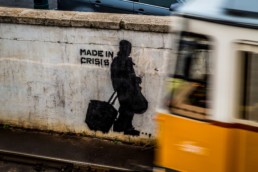An Encouraging Sign Amid Armageddon
Here it is July and the world is still wearing masks and staying home; for the most part. The numbers for the mining companies are in for the first half and they are armageddon-worthy as we might expect. De Beers revenues down 96% in the last quarter. 96%!!!! Alrosa revenues down 91%. One reason is that these two, which account for two-thirds of the world rough market, have chosen to hold the line on prices and stockpile, instead of selling at prices which have fallen 25% or more.. Who has ever seen such declines?
But… as my old De Beers friend, Robin Walker, used to tell me,… “hang on a minute…” Retail has come back reasonably well. In the US, overall retaIL sales were up 1% in June, from the previous year when we were all free to come and go and spend money as we pleased. . Who would have thought?
In the US, anecdotal reports from retail jewelers are encouraging — business is going on and, not surprisingly, on-line business is up over 50% for some jewelers. Tiffany sales , down 45% for the quarter ending April 30, may be reporting a strong rebound in the next quarter if the buzz is correct.
One major reason is the US CARES Act that injected more than $1 trillion dollars to bolster the economy through the pandemic— though the pandemic is running munch longer than many had anticipated. Dave Bonaparte at Jewelers of America told Rapaport, acknowledged that the stimulus package has helped maintain sales.
The industry is not contracting as quickly as people believed, he noted, adding that the downturn in demand has been much less severe than the 2008-10 financial crisis. He did say, however, that mall jewelers are still beset with high rents and diminished sales that cut deeply into their financial position., as evidenced by the bankruptcies of a number of large mall-oriented retails
And retail jewelers I have spoken with say that demand for lab-grown diamonds is accelerating — even making inroads in to the once sacrosanct engagement ring market.
“A lot of people don’t have much confidence in their (economic) future right now, so they don’t want to commit to a very expensive purchase, “ said one Texas jeweler.. Another, in Califronia, noting that some buyers are even looking at $25 ceramic rings, added “I look at this as a temporary situation, and I’ll try to get them to come back for an upgrade (to a natural diamond) when times are better.”
Better times may be put off if the CARES Act lapses. It expires at the end of this month and the US Congress is still flailing to come up with a replacement — which is, by no means certain.
The EU has just renewed its stimulus program so those “zombie” jobs will keep trundling on until… hopefully.. things recover to the point when many of them can be restored. Retail sales in China have bounced back, according to Chow Tai Fook’s numbers,
So the bottom line — an encouraging takeaway — is that demand appears to be robust which is a strong base to rebuild on. It is up to our industry to continue to remind consumers of the beauty and significance of our Earth’s treasures. There may not be an immediate payoff — consumers will be pre-occupied with more basics for the time being-but will will pay off in the long run for certain.
A Tsunami of Crises
I usually try to focus my comments on industry issues and how world events may affect us, but sometimes these events are so overwhelming that one cannot separate them.
This is one of those times.
The outrage of seeing a stone-faced police officer sworn to uphold the law kneeling on an unarmed man’s neck until he choked to death is deep and explosive. Especially coming, as it did, after several other unarmed African-Americans were gunned down by police for no valid reasons. This is infinitely disheartening because I was raised to think we Americans were the good guys and that such incidents were anomalies in a society striving to live up to its founding ideals.
Also, the tradegy of seeing jewelry stores—many of which belong to people I’ve long respected and admired—being looted by opportunistic criminals and provocateurs alike is also deep.
Does one have to take sides? It is slightly heartening to see that many who have had their businesses damaged understand the difference between legitimate protestors and the looters. And it is also heartening to see a Reuters poll showing 60% of Americans realize that if police had lived up their oaths to protect and serve fairly in the first place, none of this would have happened.
However, I suspect the explosion of unrest in 370 cities around the United States carries deeper roots than the outrageous conduct of police. It’s the catalyst, not the cause, and is but one aspect of the erosion of trust and belief in government and the rule of law.
In poll after poll, a large majority of Millennials and Gen Z believe the US economic system is rigged in favor of the wealthy. Many young people have been saddled with high debts, inadequate health care insurance, jobs that no longer carry benefits, increasing rents and housing costs while watching billions bonuses and “executive compensation.’
A majority of young people believe their situation will get worse, not better, according to the Pew Research study. Beyond this, they see a government that looked the other way as hundreds of thousands of its citizens became addicted to opiates while pharmaceutical companies drew record profits. Meanwhile, they also saw many of the hardest-hit states move to reduce or eliminate programs to help break the chain of addictions.
The loss of faith and hope is pervasive, and not just in the United States. This is a very volatile formula and it is very possible that this unrest will continue smoldering, erupting periodically the way is has just this past week. Remember that the arrest of a Tunisian street vendor touched off civil wars in Libya, Egypt, and the still on-going one in Syria.
We all hope and pray this does not happen, but what can we do individually and as an industry? I will be honest: I wish I knew, but I don’t, except to say don’t be consumed by hate and divisions and, above this, don’t feed them. Continue to be constructive parts of your communities and, sadly, add riot proof gates if you can.
And, in the aftermath of this violence and COVID 19, people will be looking for solace. They can take this in gifts for loved ones. And perhaps some people will want to treat themselves but not go overboard on expense, so look for line of affordable, fashionable pieces, maybe even fun. One thing is certain: “bling” will be as passe’ as a blacksmith for the time being.
NOW is the Time to Engage Consumers…Not “Later”
De Beers CEO Bruce Cleaver’s latest communique to the industry stresses the profound effects that the coronavirus pandemic has had on the everyday lives of people around the globe, and that diamonds remain a powerful symbol of connection and meaning. Diamonds have “always been attached to life’s most precious moments and relationships and represented stores of (these) values,” he said.
Mr. Cleaver is correct, of course. But he is correct in the same way that your mother was when she told you to eat vegetables instead of potato chips (or as my British friends say, crisps.) We know vegetables are healthier, but they don’t pack the same craving. And Mom telling you the same thing in the same way over and over no longer carried the message her words intended.
So how do we as an industry say the same things with a new voice? Having grown up in the 1960s, I can’t claim to speak for Millennials or Gen-Z, but from both industry experience and watching my kids’ behavior, I do know they value authenticity. So does Gen-X (the often-overlooked group born between Boomers and Millennials, who are the ones in their peak earning years now.)
What is more authentic than a diamond? It comes from deep within the earth, it is at least one billion years old, and … it can be yours. Perhaps images of rough and the resulting polished would convey that message even more graphically. In addition, what else can connect us to our Earth we care about more closely than a diamond, which we can fit into the responsible-sourcing-brings-responsible-outcomes message that will resonate with these climate-conscious consumers?
The 1960s, when I came of age, offer a parallel. There was a powerful anti-materialistic, anti-status sentiment going around in that decade, but 10 years later we Boomers were buying diamonds for our intendeds and shopping around for the best mortgage rates, so the latent desire is there. We just need to tell our story in a way that today’s consumers will listen.
And we need to tell it NOW. Industry posts are filled with industry leaders (including Cleaver) and pundits talking about plans for the post-pandemic world, saying ‘We will begin this after the world begins to get back to normal.”
Not “after.” Start now.
Right now we have a captive audience. Social media traffic has more than doubled in the lockdowns. I have never seen so many photos of fuzzy puppies, pratfall GIFs, lockdown recipes and stupid quizzes. Show people diamonds! Give them a story that’s authentic and engaging. Plant the seeds now. It will be a tangled jungle once the lockdowns lift, and much more difficult to get our message heard.
Also, there’s an additional reason for NOW. People around the world have cancelled their holidays and many will have those funds to spend. Travel always has been a big competitor to diamond jewelry, but right now the travel industry is facing very serious trust issues: stories are emerging about hotels and resorts refusing to return deposits or pre-paid reservations (to wit: Basel), travel agencies losing track of customers’ funds, and cruise ships have their own horror stories (no need to elaborate).
Going forward, the reality of the post-pandemic world will be difficult. A lot of lost jobs will not come back. More may even be lost as economic ripple effects spread. As such, the world economy will be operating at a much-reduced level at least through this year and probably part of next year. Our industry must adjust to this lower level of trade (remember when De Beers and Alrosa stockpiled diamonds?) while at the same time seize the opportunity to build a future with a new message to consumers whose priorities will be changed, but whose desires will remain the same.
Profit From The Long Game
Sustainability. It’s today’s buzzword but, beyond the buzz, it’s hardly new because it encompasses basic things like trust, ethics and responsibility.
When I started in the gem trade I was made acquainted with the spirit of Mahzal u’ Bracha. Luck and blessings. “Take the stones and pay for them after you made your deal…I trust you.” Some people abused this trust but in general, the system worked and still works. The colored gem trade wasn’t quite as formal but it did (ad still does) operate in a spirit of competitive collegiality that demanded certain ethical trading standards were met.
However ethical dealers may have traded within their own community, the least asked question about any particular stone always was “where did it come from?” If the 4Cs checked out, or the color was right and the price, after haggling, allowed a decent profit. Who cared whether it illicitly mined, stolen, mined under exploitive circumstances or cut in a sweat shop?
Who cared? …Until some people started caring.
Conflict diamonds brought the movie Blood Diamond (and the lesser known Lord of War) and on from there. Now sustainability had to extend far beyond ethical trading within the confines of the gem community. The diamond trade understood this necessity fairly quickly, but the colored gem trade, being very fragmented and without a De Beers/father-figure, has been much more slow to react, though there is good progress.
It will cost more to give artisanal miners a fairer return on their labors. IT will cost more to help develop ancillary activities around mining site to provide other incomes and sustenance for miners’ communities. It will cost more to improve working conditions in cutting operations. But in the long game, the money will come back
Here’s a real-life case in how this can happen: In the mid-1980s India’s diamond cutting industry had grown mightily in the 10 years leading up to that time. But working conditions for people in diamond factories were appalling. I witnessed them myself. No chairs, only hard pillows, no safety precautions or ventilation (I developed aggravating respiratory infections after my visits), poor pay and, yes, a too many under-age workers. The product suffered. Complaints mounted about out -of-round diamonds falling out of mountings or diamonds that just looked dead from burns and abrasions. And there were rumblings from social organizations about children cutting diamonds.
Both De Beers and Rio Tinto acted; obliging their clients improve working conditions — immediately. Many companies balked at the costs of building new, healthy, safe places to work but if they wanted to be supplied with rough diamonds they complied. By the end of the decade, India boasted some of the safest, most modern diamond operations in the world. Places where I didn’t need to see a doctor after visiting. The product (and productivity) greatly improved, Workers were rewarded, with cleaner workplaces and better pay but more rewards, in the form of supply contracts with major US, Japanese and European jewelry companies, went to the business owners. In short, they made an investment in the long term that made their businesses much more profitable than continuing the old way.
Can we transform other sectors of our industry in the same way? Many are working on it but it is not easy because there’s so much invested in the status-quo. The real challenge is changing minds because almost no one looks up when they are counting money. Only when the money stops flowing do they ask what happened.
Adopting responsible practices may mean there’s a bit less money to count in the short run, but the pay-out will be much, much longer. And that’s where the word “sustainable” has real meaning.
In future columns, I will address how these lessons can be applied though the supply chains in a realistic market oriented way.
Community and Corona
The Corona Pandemic is affecting the lives and livelihoods of millions of people around the globe and our industry is surely in for a few very slow months— people are into survival mode, thinking more about essential supplies rather than jewelry.
In these times retail jewelers can win immense goodwill by providing support for their communities — paying their employees sick leave if they don’t qualify under the recent USA legislation, if they are not already doing so — including allowing employees to take off to help and ill family member; sponsoring testing in areas which are not participating in such measures, and supply-drives to help those unable to stock up on essentials.
Then, announce this police in place of the usual promotional special sale of the week, and in your social media posts. Stress your ties to the community.
Of course it will be a difficult decision because, without a miracle, we are all in for a pretty soft first half of the year, which may knock on to the second half. The temptation to spend as little as possible is there, but think of this as an investment, rather than an expense.
This idea come to me when the GIA announced it was ensuring all of its employees would have adequate sick leave, including time to care for a family member if they became ill. Even though I had just left, I felt a strong surge of pride that I worked 19 years for an organization that cared so much about its workers. Some local utilities have pledged not to cut or suspend services for customers behind in their bills and I have read of other local businesses pledged to pitch in with resources, even sponsoring testing, if the tests are not paid by the state or federal government. I will damn sure patronize them once this pandemic winter passes over.
Businesses are integral parts of every community and jewelers are an integral part of neighbors’weddings, graduations, anniversaries and — perhaps even a guilt trip— and there’s no more effective way of demonstrating commitment to your community than by coming through in a time of need. People don’t forget that.
I created this website to advise and comment on issues regarding sustainability and best business practices, which most people tend to think of pertaining to gemstone mining and cutting, but not at the retail counter. But this is where the goodwill of the consumer counts to most so it’s very relevant here.
With all the negativity going on, this is a chance to be different — way different — and the goodwill that will come back will be much greater than any 20% off sale will ever generate.




